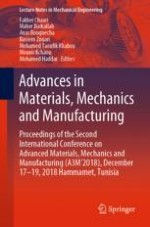2020 | Book
Advances in Materials, Mechanics and Manufacturing
Proceedings of the Second International Conference on Advanced Materials, Mechanics and Manufacturing (A3M’2018), December 17–19, 2018 Hammamet, Tunisia
Editors: Prof. Fakher Chaari, Prof. Maher Barkallah, Prof. Anas Bouguecha, Prof. Bassem Zouari, Prof. Mohamed Taoufik Khabou, Prof. Mounir Kchaou, Prof. Mohamed Haddar
Publisher: Springer International Publishing
Book Series : Lecture Notes in Mechanical Engineering
